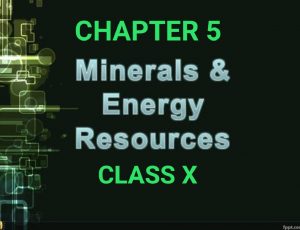INTRODUCTION: MINERALS & ENERGY RESOURCES
Minerals and energy resources is a chapter which you have already read in class viii.
However, for class X, you need to study in details.
You have already read about the Resources and development in the first chapter.
Therefore, you are already familiar with these two terms Minerals and energy resources.
Minerals are important for the development of any nation.
In this chapter we will mainly discuss about the importance and types of minerals.
Also, what are the different types of minerals and where are they found.
How minerals and energy resources are important for us.
And how can we contribute in conserving these resources.
CHAPTER 5 – MINERALS AND ENERGY RESOURCES:

GEOGRAPHY: MINERALS AND ENERGY RESOURCES
Have you ever thought why do we keep our Gold and Silver ornaments hidden?
Yes, because they are costly and precious.
Therefore, nature also hides these minerals within the earth’s crust.
We take out these minerals to make many things as per our requirement.
These minerals help us in making car, bus, Aeroplanes, roads, paints, buildings etc.
Our body also needs 0.3 % of minerals to function properly.
WHAT IS A MINERAL?
Minerals are basically the combinations of similar substances.
Geologists define as ” Minerals are homogeneous naturally occurring substance with a definable internal structure.”
They have a very wide range – very hard to very soft.
Till now, we have identified more than 2000 varieties of minerals.
WHERE CAN WE FIND THESE MINERALS?
Minerals are hidden.
Think of the places where you hide your things at home.
Under the mattress, in the bundle of old books and copies, inside a cartoon.
A child generally hides a test copy in which he has scored poor marks – In the old newspaper bundle.
However, you are not able to hide it for long.
Similarly, nature also hides the minerals at five different places:
i) Basically, it is between the layers of sedimentary rocks.
ii) Mostly, Metallic minerals in the Igneous and Metamorphic rocks.
iii) Lighter minerals, under the top-soil or sub-soil.
iv) in the sand near the river banks and
v) in the sea or oceans.
i) BETWEEN THE LAYERS OF SEDIMENTARY ROCKS:
You must have enjoyed eating a Berger or a sandwich.
What do you see?
You find some stuff packed between the layers of bread.
Similarly, there are rocks which have layers known as sedimentary rocks.
Between the layers of these rocks, nature hides non-metallic minerals like coal, potash, salt, Gypsum, Oil etc.
ii) IN THE IGNEOUS AND METAMORPHIC ROCKS:
Igneous and Metamorphic rocks also contain minerals.
When these rocks are in the process of formation, minerals get trapped between the cracks or joints.
When minerals are in less quantity, it is veins. Larger quantity of minerals in rocks are the lodes.
Generally, we get metallic minerals from these rocks such as copper, zinc, tin, lead etc.
iii) UNDER THE TOP-SOIL OR SUB-SOIL:
If you just remove the soil you will get some minerals.
They occur on the outer surface of the earth’s crust.
They are not very deep.
Sometimes, when the soil erodes or the surface rocks decomposes, these minerals are visible.
We get Bauxite (an ore from which aluminium is extracted) in this way.
iv) IN THE SAND NEAR THE RIVER BANKS:
Some very precious particles of metals can be seen mixed with the sand along the river banks.
This is known as placer deposits.
If you go to Jamshedpur, you will find many people engaged in filtering the sand on the banks of river.
In a day or two, they may get half or one gram of gold if they are lucky enough.
There was a time when enough gold and silver particles were found on the bank of these rivers.
Find out the name of the river on whose bank Jamshedpur is located and why it is so called?
v) IN THE SEA OR OCEANS:
Some of the minerals are also found in the ocean waters.
Although these minerals get diffused (destroyed) due to the presence of salt.
However, Manganese and common salt are generally obtained from the sea water.
INTERESTING FACT:
Rat hole mining https://shapingminds.in/मेघालय-रैट-होल-माइनिंग/ is a way of taking out coal from the mines in Meghalaya by the tribal people.
FERROUS MINERALS (MINERALS AND ENERGY RESOURCES)
1. IRON
Minerals which contain iron are called Ferrous minerals.
Iron is the most important ferrous mineral.
It is used to make steel, utensils, machines, bridges, etc.
Look yourself and see around which all things you use everyday to understand the importance of iron.
your school bag, belt, pin, instrument box, tie pin, safety pin, etc contains iron.
Therefore, it is a basic mineral and backbone of all industries.
India has abundant and good quality iron ore reserves.
Two types of iron ores found in India are Magnetite and Hematite.
Magnetite has very high content of iron (70%) whereas Hematite has 50-60% of iron.
However, Magnetite is mainly preferred in electrical industries.
Whereas, Hematite is more common as industrial iron.
DISTRIBUTION OF IRON ORE:
Distribution of iron ore means mentioning about the regions where iron ores are found in India.
Question asked from this topic in exam is:
Q 1. Name two types of Iron ores found in India. Also mention about it’s distribution. (5)
Ans) Two types of iron ores found in India are Magnetite (with 70% iron) and Hematite (with 50-60% iron)
DISTRIBUTION OF IRON ORE:
I) ORISSA-JHARKHAND BELT:
a) High grade Hematite iron ore is found in this belt.
b) major districts in Orissa are Mayurbhanj and Kendujhar.
c) major district in Jharkhand is Singhbhum.
II) DURG-BASTAR CHANDRAPUR BELT:
a) This belt lies in Chhattisgarh and Maharashtra.
b) High grade Hematite iron ore ( for making steel) is found in Bastar siatrict.
c) Subsequently, Iron ore is also exported to Japan and Korea from Vishakhapatnam port.
III) BELLARY-CHITRADURGA- CHIKMAGLUR BELT:
a) This is a belt which lies in Karnataka.
b) Kudremukh mines (located in W.Ghats) are one of the largest mines in the world.
c) However, 100 % iron ore is exported as slurry through pipeline from Mangalore port.
IV) MAHARASHTRA-GOA BELT:
a) Iron ore is mainly found in Goa and Ratnagiri district of Maharashtra.
b) The iron ore found here is not of very high quality.
c) Still, Iron ore is exported through Marmagao port.
2. MANGANESE:
Q 2. Mention three uses of Manganese? (3)
I) Mainly used in making steel.
ii) Also used in making bleaching powder and paints.
iii) Insecticides are also made from manganese.
NON-FERROUS MINERALS: (MINERALS AND ENERGY RESOURCES)
Non- Ferrous minerals are the minerals which do not contain iron. Important Non-ferrous minerals are:
1 COPPER:
Three features of copper are:
a) India has acute shortage of copper.
b) It is used in electrical cables, electronics and Chemical industries.
c) However, it is found in Balaghat mines in Madhya Pradesh in good quantity.
Therefore, India imports copper.
2. BAUXITE:
Three features of Bauxite are:
a) Aluminium is extracted from Bauxite.
b) it is a light metal and good conductor of heat and electricity.
c) Used in making utensils, electrical wires, aluminium foils etc.
Orissa is the largest producer.
NON-METALLIC MINERALS:
Non- Metallic minerals are the minerals which do not contain metals. Important Non-metallic minerals are:
- MICA:
a) Mica is known for it’s di-electric strength, insulating properties and resistance to high voltage.
b) It is used in electrical and electronic industries.
c) Jharkhand (Koderma – Hazaribagh belt) is the largest producer.
2. LIMESTONE:
a) mainly found in sedimentary rocks.
b) Basic raw material for the cement industry and used for smelting iron in steel industries.
c) while processing, gives out too much of dust making it a killer industry.
HAZARDS OF MINING:
i) dust inhaled by miners can lead to pulmonary (Lung) disease.
ii) mine roofs can collapse anytime..
iii) Similarly, polluted water also causes many type of diseases.
iv) continuous irritating noise and vibration cause musculoskeletal disorders.
v) underground water enters the mines.
vi) At the time of mining, sometimes mines catch fire also.
Therefore, these are some common threats to miners.
CONSERVATION OF MINERALS:
Why do we need to conserve our minerals?
Ans) We need to conserve our minerals because:
i) it requires millions of years to get created.
ii) rate of consumption is higher than the rate of formation and
iii) minerals are finite and non-renewable.
How can we contribute in conserving our mineral resources?
Ans) We can contribute in conserving our mineral resources in the following ways:
i) by using improved technologies.
ii) by Recycling and reusing of metals and scrap metals and
iii) by depending on other alternatives and using the resources in a planned manner.
ENERGY RESOURCES: (MINERALS AND ENERGY RESOURCES)
There are few resources which give heat and energy after burning.
Most of the fossil fuels like coal, petroleum and Natural gas give energy after burning.
We can get energy from waterfall, solar, wind, uranium, dung cake etc.
However, the use of dung cake must be discouraged because it is also the most valuable manure in agriculture.
Two types of energy resources are Conventional and Non-conventional.
i) CONVENTIONAL SOURCES OF ENERGY:
a) Resources which we cannot reuse after using it once are conventional resources.
Moreover, these are non-renewable resources.
b) They have been in use since a long time.
c) However, most of these resources cause pollution when used.
c) examples are coal, petrol, natural gas, cow-dung etc.
ii) NON-CONVENTIONAL SOURCES OF ENERGY:
a) Resources which are used again and again are non-conventional resources. These are renewable resources.
b) These resources are new and are still developing.
c) However, they do not cause pollution when used.
d) examples are solar, wind, hydro electricity, Geo-thermal etc.
USES, TYPES AND DISTRIBUTION OF COAL IN INDIA:
India has large reserves of coal. It fulfills most of our energy needs.
Three uses of coal as a resource are:
a) We get thermal energy by burning coal.
b) It is also a major fuel in industries.
c) also an important source of energy for domestic needs.
TYPES OF COAL:
Coal takes millions of years in it’s formation.
Coal may be of good or bad quality.
The type of coal depends upon the on three factors.
i) Degree of compression (under how much pressure it remained compressed)
ii) Depth (how deep it was buried under the ground)
iii) Time (for how long it remained compressed)
Four types of coal found in India are
a) ANTHRACITE:
It is the hardest coal.
Contains 80 to 90 % carbon content. It burns quickly.
When it burns, it gives out more heat and less smoke.
It is rarely found but is the best type of coal.
If you see, it is dark black in colour and it shines.
b) BITUMINOUS:
It is the second best type of coal.
Contains 70 to 80 % carbon content.
It is found in abundance in India.
For industries, it is the best suited coal.
Therefore, it is also known as Metallurgical coal. It is black in colour.
c) LIGNITE:
Third grade coal is Lignite.
It is brown in colour with low (50 to 60 %) carbon content.
This coal is generally soft with high moisture content.
In the absence of the other two types of coal, it is used for the generation of electricity.
d) PEAT:
Peat is the worst quality coal.
It is light brown in colour and is very light.
It takes time to ignite.
When it burns, it gives out more of smoke and less heat.
Decaying plants in swamps produce peat.
DISTRIBUTION OF COAL IN INDIA:
Coal in India was formed in two main Geological ages. Gondwana age and Tertiary age.
Gondwana period:
a) Coal which was buried inside the earth over 200 million years ago.
b) Gondwana coal is found in Jharkhand, W.B., Orissa, Chattisgarh etc.
c) Good quality coal mainly used as metallurgical coal.
Tertiary period:
a) Tertiary coal formation is 55 million years old.
b) Quality of coal is poor.
c) However, in India, it is found in Assam, Meghalaya, Arunachal pradesh and Nagaland.
PETROLEUM: OCCURRENCE AND IMPORTANCE
After coal, Petroleum is the second most important energy resource in India.
Moreover, It is found deep inside the earth between the layers of sedimentary rocks.
It is found as crude oil which is black in colour.
After extracting this crude oil, it is sent to the refineries where it is cleaned.
We get kerosene, diesel and petrol after refining. As this resource is very useful, it is often called as LIQUID GOLD.
OCCURANCE OF PETROEUM:
A) Petroleum sources are associated with anticlines and fault traps.
B) It is found between porous and non-porous rocks.
C) The occurrence of petroleum is the result of chemical, physical and geological factors.
D) It was formed from the dead organisms present in the sea.
IMPORTANCE OF PETROLEUM:
A) It is the major energy source in India.
B) Commonly used as a fuel.
C) Provides lubricant for machinery.
D) Many byproducts of petroleum is used to make wax, body lotion, synthetic clothes, fertilizers etc.
E) Petroleum is also a raw material for many industries.
Therefore, it is often called as Nodal industry.
NATURAL GAS:
Natural gas form from dead organisms.
Moreover, dead organisms when decompose in the absence of air under high pressure and temperature.
It is also found within the layers of sedimentary rocks.
when petroleum vaporizes within the earth, the vapour (natural gas) remains at the top of petroleum.
However, It is found with or without petroleum.
Liquefied petroleum is used in gas cylinders.
In addition, it is stored under high pressure as compressed natural gas (CNG).
However, today vehicles use CNG as it is comparatively cleaner fuel and creates less pollution.
NON-CONVENTIONAL SOURCES OF ENERGY: (MINERALS AND ENERGY RESOURCES)
As mentioned above, Non-conventional sources of energy are renewable and pollution free.
At the same time, they are also available in large quantity at free of cost.
India has enough potential to make use of such energy resources.
Our country has enough of sunlight, water and wind.
How non-conventional sources of energy is beneficial to India?
Renewable sources of energy is definitely better for India because:
i) non renewable sources of energy will create pollution.
whereas, renewable energy sources are pollution free.
ii) increase in price of oil and natural gas increases burden on poor Indians.
iii) some sources of energy are limited.
Shortage and supply of such resources are uncertain in future.
SOLAR ENERGY:
India is a tropical country. It receives bright sunshine for more than 10 months in a year.
Therefore, it has enough possibilities of using this energy.
Solar energy is free of cost and poor people in India can easily afford.
As solar energy is a clean source of energy, it will also contribute to environmental conservation.
It will also minimise the dependence on fire wood and dung cakes.
Further, the largest solar plant is working at Madhapur in Gujarat.
with the help of solar energy milk cans are sterilized.
WIND ENERGY:
Wind power costs less.
Moreover, It is also clean and pollution free.
Use of wind energy will reduce fossil fuel consumption.
It can also provide power to remote locations.
India has tremendous potential of utilising wind energy especially in coastal and desert regions.
The largest wind farm cluster is located in Tamilnadu from Nagarcoil to Madurai.
BIOGAS:
We get Bio-gas mainly from shrubs, animal and human waste.
It fulfills the requirements of fuel for domestic consumption in rural areas.
Moreover, when the wastes decomposes it yields gas.
This gas produced has higher thermal efficiency.
Useful at individual level also.
Gas coming out from the cow dung, is called Gobar gas.
It serves two purposes:
i) provides energy to the farmers.
ii) the remains of dung cake becomes quality manure for the farms.
TIDAL ENERGY:
High tides in the oceans and seas are very useful to generate electricity.
Tides are predictable and power plants are inexpensive to maintain.
It is highly reliable, renewable and pollution free source of energy.
HOW IT WORKS:
Initially, https://www.youtube.com/watch?v=68re4vwKy8g Floodgate dams are built across water inlets.
Moreover, during high tide, water enters the gate of dam.
During low tide, water comes out from the flood gate.
After that, the force of water rotates the turbine and generates energy.
GEO THERMAL ENERGY:
Energy present in the interior of the earth is the Geo thermal energy .
As we go inside the earth’s crust, the temperature increases.
Rocks are in contact with this heat, therefore becomes hot.
The water present over the rocks heats up and turns into vapour.
This steam rotates the turbine and produces energy.
Meanwhile, two experimental projects are working in India.
One in Parvati valley near Manikaran in Himachal pradesh and the other in Puga valley in Ladakh (J&K)
CONSERVATION OF ENERGY RESOURCES:
Energy is a basic requirement for the development of any country.
Every sector weather commercial or domestic needs energy.
The demand and use of energy resources is rising all over the country.
Therefore, there is an urgent need to conserve our energy resources.
Otherwise, there will a severe crisis of energy in the country.
WAYS TO CONSERVE MINERALS AND ENERGY RESOURCES:
i) First, to adopt a cautious approach for judicious use of our available resources.
ii) Secondly, to create awareness among the people about the importance of energy resources.
iii) Third, by using public transport and not private vehicles.
iv) Next, by minimizing the use of electricity by using power saving devices.
v) Lastly, by using renewable sources of energy.
CONCLUSION: MINERALS AND ENERGY RESOURCES
Energy is the capacity to produce, consume and innovate.
People say ” SAVING ENERGY IS PRODUCING ENERGY.”




0 Comments